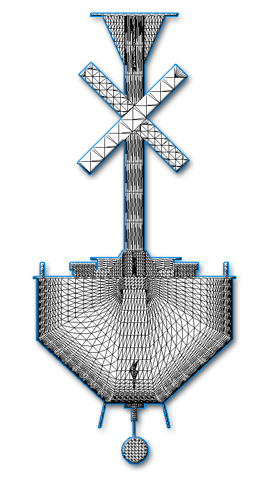CUSTOMIZE YOUR SONS SYSTEM
SONSETC can customize any integrated system to fulfill the customer requirements. The solutions that SONSETC offers may include the SONS-DCL software that automatically detects and classifies acoustic events as well as continuously monitors noise in real-time. This unique technology is exclusive to SONSETC. The interface and output of the analysis can be found at http://listentothedeep.com. Click here to customize your system Below are a few examples of integrated systems: |
AUTONOMOUS SELF-POWERED BUOY MONITORING STATION
(A1-SONS, A2-SONS)
Acoustic monitoring and noise measurement station The station performs: Additional options: |
ACOUSTIC MONITORING & NOISE MEASUREMENT & REAL-TIME TRANSMISSION: 
|
||||||||||||||||||
TRAWLER SAFE MONITORING STATION
(B1-SONS, B2-SONS)
Operational times for submerged acoustic monitoring and noise measurement station
The station performs:
- measurement of peak and RMS signal levels
- measurement of RMS noise in two or three selected frequency bands
- measurement of European Marine Strategy Directive ‘Indicator 11.3’ (Noise) reference values (third-octave around 63 and 125 Hz)
- third-octave noise measurements on the whole bandwidth (optional)
- detection of impulses in two or three selected frequency bands
- detection of short tonal events (whistles)
Optional (would require additional hard disk space):
- recording of segments based on exceeding a pre-defined threshold
- storage of spectrograms
Operational modes (can be custom configured):
- continuous: in this mode the system is continuously analysing the incoming acoustic data
- activity monitoring: the system records for a full hour, 6 hours per day distributed over the day to give an indication of the activities in the area. The recordings are not necessarily at the same time each day to obtain a good overview of a whole day.
- activity sampling: the system records for 15 minutes, 12 times per day
- noise sampling: the system records 5 minutes per hour; this mode is most useful to obtain an overview of the background noise levels over large periods of time.
Assuming deployment with 4 batteries (12V / 160 Ah) and 6W consumption:
Operational mode* |
Operational time (estimates) |
1. Continuous |
13 days |
2. Activity monitoring |
45 days |
3. Activity sampling |
100 days |
4. Noise sampling |
150 days |
|
|
ACOUSTIC MONITORING & NOISE MEASUREMENT & HARBOUR PORPOISE DETECTION
OPTION 1 SYSTEM (B1-SONS) - non calibrated hydrophone |
OPTION 2 SYSTEM (B2-SONS) - calibrated hydrophone |
||||||||||||||||||||||||||||||
|
|
AUTONOMOUS RECORDING STATION
(D11-SONS)
| In June 2008, the Directive 2008/56/EC established a framework for community action in the field of marine environmental policy (Marine Strategy Framework Directive). The main objective of this Directive is the achievement and/or maintenance of good environmental status of the European marine waters by 2020. Member States of the European Union are encouraged to collect data to define quality objectives for the achievement of good environmental status, following a series of descriptors. Descriptor 11 concerns the introduction of energy, including underwater noise, in the marine environment and specifically the measure of ambient noise level within 1/3 octave bands centred at 63 and 125 Hz. D11-SONS is an autonomous recording station that is designed to fulfil the Marine Strategy Framework Directive Descriptor 11 and to provide the member state administrations with an integrated solution to monitor ambient noise. The station performs: - measurement of noise indicators as defined in the Marine Strategy Framework Directive Operational mode: Noise sampling: the system records 15 minutes in total per day. |
|
BCUBE
| The BCUBE is a portable audio acquisition and analysis solution that allows data to be immediately assessed and
distributed among local observers or globally over the Internet. Either an analogue or digital hydrophone (through an Ethernet port)
can be connected. In addition, a GPS/AIS receiver is integrated into the box to both track its own location and shipping activities
in the area. Data is acquired, stored and analysed by
SONS-DCL software. The standard analysis includes detection of impulsive and whistle-like signals and noise measurements in bands of interest.
The analysis results (including spectrograms of the data and an optional MP3 stream to allow human observers to inspect the data) can be accessed through Ethernet or over a WiFi connection, or the results can be transmitted over a 3G or satellite
radio link to a remote location. The portable case can be configured with a battery to allow an autonomous run-time of a few hours (depending on powered peripherals) and
it can be powered by an external source. |
 |
SONS-DCL
| SONS-DCL is a software package to automatically process an acoustic datastream in real-time. It contains several independent modules, such as dedicated modules for noise assessment, detection, classification and localization of acoustic sources. The software can run on Linux, UNIX, and Windows systems. An overview of the modules is shown in the figure below. SONS-DCL has been used for an international project under the European Sea-Floor Observatory Network of Excellence, ESONET, titled ``Listen to the Deep Ocean Environment (LIDO)´´ led by the The Laboratory of Applied Bioacoustics (LAB) of the Technical University of Catalonia (UPC, Barcelona Tech). SONS-DCL framework is currently active at the ANTARES (http://antares.in2p3.fr) neutrino observatory, the OBSEA (http://www.obsea.es) shallow water test site, the NEPTUNE Canada (http://www.neptunecanada.ca) observatory, the JAMSTEC (http://www.jamstec.go.jp/e) network of underwater observatories and at the NEMO (http://nemoweb.lns.infn.it) site after the observatory has been redeployed. The analysis results are directly made available on the Internet where they can be viewed with a specific application. The public interface can be found at http://www.listentothedeep.com. Additionally, SONS-DCL is being evaluated on autonomous gliders and towed arrays in collaboration with the NURC (http://www.nurc.nato.int). | |
|
|
CUSTOMIZE YOUR SONS PRODUCT









